ISSN ONLINE(2319-8753)PRINT(2347-6710)
ISSN ONLINE(2319-8753)PRINT(2347-6710)
Vikash Agarwal1, Rajeev Kumar Upadhyay2
|
| Related article at Pubmed, Scholar Google |
Visit for more related articles at International Journal of Innovative Research in Science, Engineering and Technology
In this paper study of musculoskeletal disorders of workers in brick kiln industry has been carried out. This study shows the relationship between Occupational Health Hazard (OHH) and Expected Earnings. Four parameters namely rest break (RB), working hours (WH), switching over for alternate job (SOAJ) and working hours between two consecutive breaks (WHBTCB) were considered. In the present study 10 brick kilns industry of medium and small scale were selected in the adjacent areas of Etawah (Uttar Pradesh), India for physiological assessment. The data related to musculoskeletal disorders in different muscles of human body were obtained and is optimized by using artificial neural network (ANN) and genetic algorithm (GA).
Keywords |
| Musculoskeletal Disorders (MSD), Occupational Health Hazard (OHH), Artificial Neural Network (ANN), Genetic algorithm (GA) |
INTRODUCTION |
| Complaints originating in the musculoskeletal system are one of the most common categories of illness among industrial workers. Musculoskeletal complaints account for 30% of time loss through sick, increase in musculoskeletal illness. The musculo-skeletal disorders may manifest in the form of stiffness, fatigue, weakness and power loss etc. It may occur in various parts of body (neck, shoulder, arms, wrist, elbow etc.) and with varying frequency for each individual/ operational worker. Many jobs and activities require manual material handling such as loading and unloading, removing material from conveyor belt, storing items in ware houses etc. Manual material handling activities affect primarily the musculoskeletal system. Overexertion appears to be the main reason for manual material handling problem. An industry which has the main aim of increasing its production inevitably has to work under such environment which undergoes continuous humanistic and mechanistic interactions with several not well defined classes of boundaries leading to imprecision. In brick kilns industry large numbers of male and female workers do different type of work such as moulding of bricks, lifting bricks, etc. due to which they suffers from musculoskeletal disorders due to repetitive work under unfavorable conditions. Disorders are linked to jobs that are repetitive, require high forces, and require continuous or repeated extreme or awkward postures which may affect the bodyâÃâ¬ÃŸs soft tissues, including damage to the muscles and nerves of hand, elbows, wrist, shoulders, neck and back. Such disorders / pain in the neck, hand shoulders cause work disabilities among employees. A repetitive task is defined as work requiring repeated performance of similar cycles of work activities. Cycles are considered similar if the developed muscle forces, time sequences and spatial characteristics of movements are similar [13, 14]. The prevalence of clinically verified cumulative disorders ranged from 1% to 25% in an industrial work population according to the force demands and repetitiveness of the workâÃâ¬ÃŸs tasks [1]. In brick industry workers do moulding work continuously up to 8 to 10 hours and their wrists are in continuous perceived exertion (PE) for this duration. They usually complain about wrist pain which is ignored by the supervisors and owners. The over PE causes reduction in the efficiency of workers, which in turn affects the production of further raw bricks adversely. |
| Genaidy et al. investigated the effect on discomfort of maintaining a fixed posture about various joints and investigated the effects of posture on discomfort seen as precursor of injury if work is continued. Tanaka et al. recommended that the wrist angle be defined as sum of proportions of measured wrist angles while performing the tasks in relation to the ROM (range of motion) in each direction of wrist bending. Moore et al. found in their study that musculoskeletal disorders are related to repetitive tasks and led to the development of a model that makes it possible to express incidence of disorders as a function of exerted force and time sequences of load and recovery. Kahn et al. also focused on the problem of maintaining load for an „infiniteâÃâ¬ÃŸ time. They proved that the maximum force maintained for 4 min decreased hyperbolically. Lin et al. established equal discomfort levels for the wrist is relation to exertion level, movement, frequency and flexion only, for 1 h of work. Kee derived regression equations for the Joint Angles of Discomfort (JAI) where subjects maintained static pressures at 0%, 25%, 50%, 75%, 100% of the range of motion for 60 sec but there was no dynamic activity studied. |
II. RESEARCH METHODOLOGY |
| For physiological assessment of existing and improved tasks/ postures/ conditions following methodology were used. Visit to selected organizations. Selection of Workers. Study of existing postures/tasks/conditions. Suggest improved postures/tasks/conditions. On line experimentation on existing and improved postures/tasks/conditions. To study the physiological assessment, visit of the brick kilns in the adjacent areas of ETAWAH (Uttar Pradesh) that has a concentrate of kilns, has been done. Formal as well as informal procedures were adopted for this purpose since different policies were followed by different organizations. It was not possible to have the exactly similar study. Few organizations allowed the videography and rest permitted only still photography; however some industrial organization were not ready for any type of photography and on site physiological assessment. They were not considered as part of the study. The initial visits to the brick kilns had to be organized with the help of the local Brick kiln owner. Number of visits had to be made to the kilns to finally make the owners agree to allow us to meet the workers Initially very minute and detailed studies of different workers about existing Postures/tasks/conditions were observed and only those workers were selected, who had some complaints of musculoskeletal nature due to their job profile and work environment. The following triggering question were posed to workers to identify the most important postures/tasks due to which they feel that they were suffering from musculoskeletal disorders and back pain.“Which of the task/ posture according to you has the greatest potential on your musculoskeletal disorders and back pain?” “After how long do you feel the pain in different muscles?” etc. In brick kiln industry generally seven types of tasks were done. Table -1 shows a list of different tasks. |
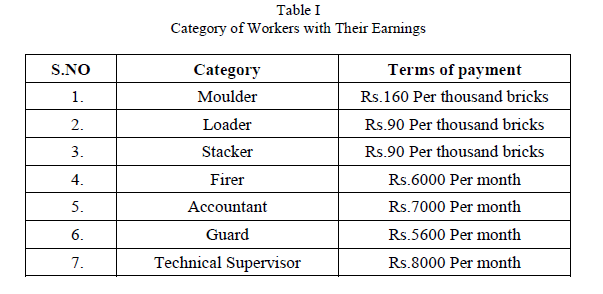 |
| In moulding work we intended to investigate the wrist discomfort levels of workers involved in brick moulding work with variation in following parameters. ïÃÆÃË RB: Rest break: It is defined as time interval taken by workers after they get tired because of doing continuous work. ïÃÆÃË WH: Working Hours: Working Time taken by the workers during the whole day. |
| SOAJ: Switching Over for Alternate Job: This is done in order to reduce health hazards pertaining to one type of job for long working hours. ïÃÆÃË WHBTCB: Working hours between two consecutive breaks: It means that after how much time rest break was provided. In this context we took the real life data from different Brick Kiln Industry near Etawah with the permission of owners. The discomfort levels would be measured based on perceived exertion by the workers on different working parameters as mentioned below. Workers: Following three workers were considered in this project. Worker Age W1 24 W2 37 W3 46 Workers were doing continuous work for four hours. They took one hour rest for lunch break (unavoidable) and then do continuous work. Four working hours were divided into three sessions 80 min. each. The following table II depicts perceived exertion (PE) of work by workers and their corresponding value on 1 to 10 scale. |
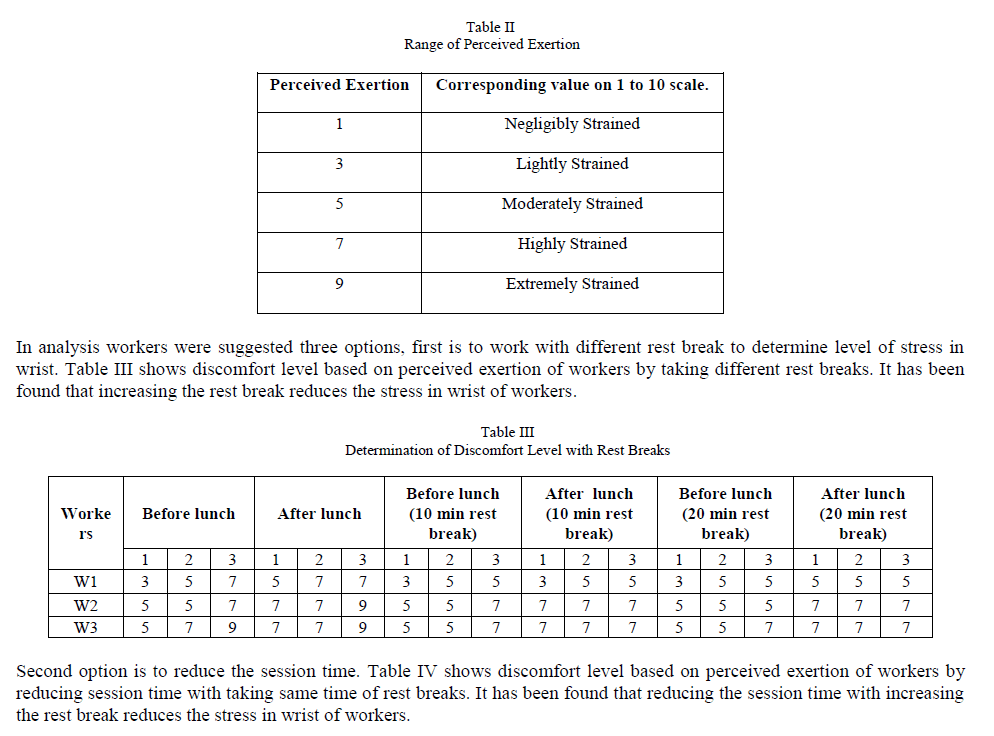 |
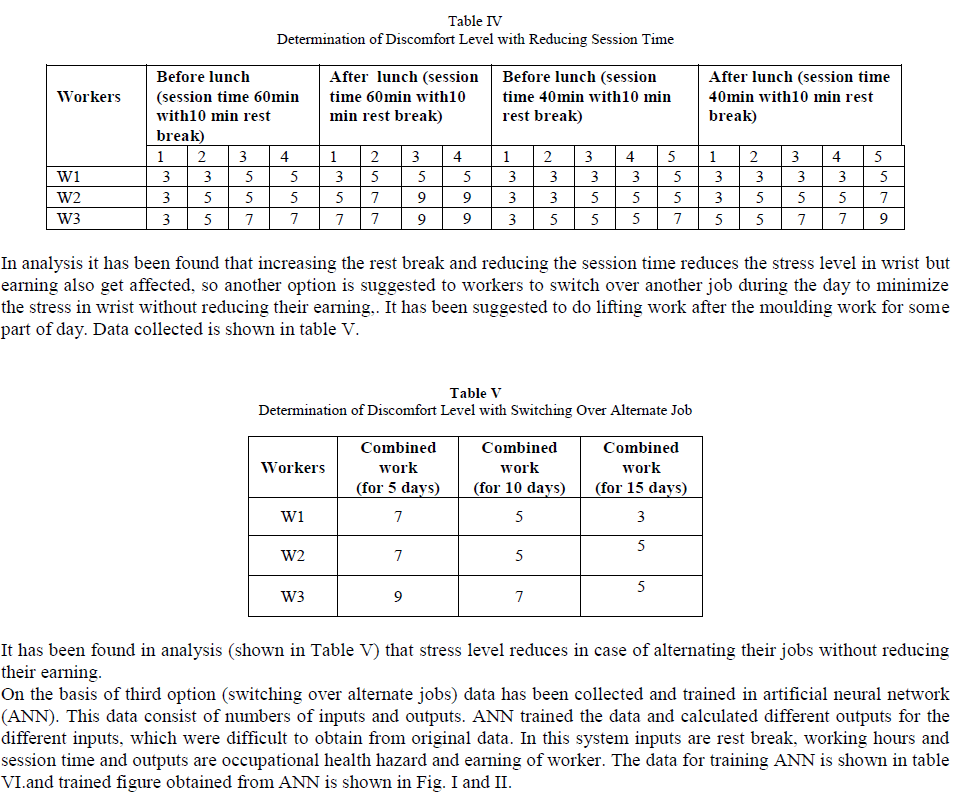 |
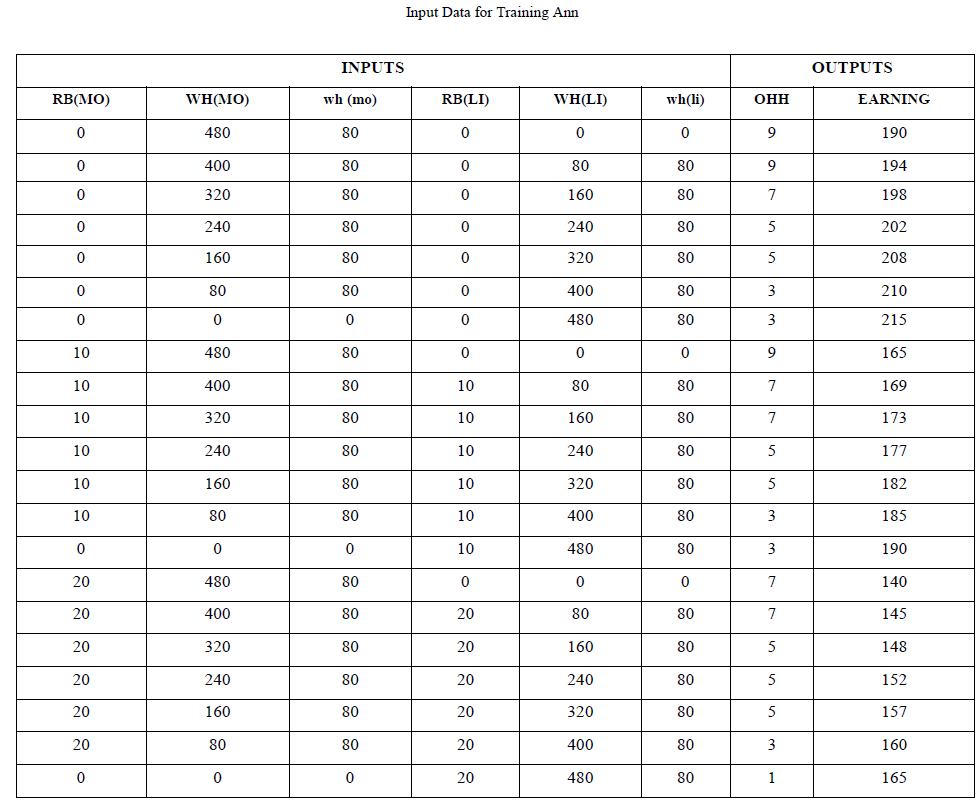 |
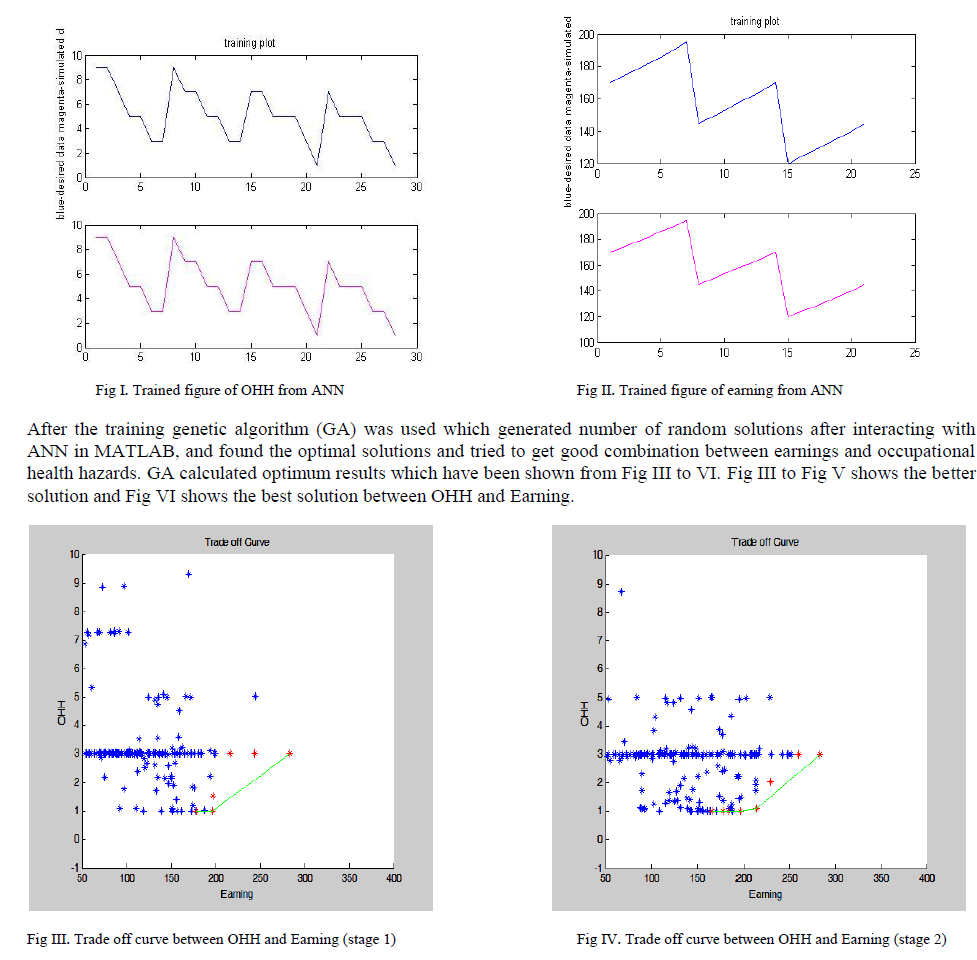 |
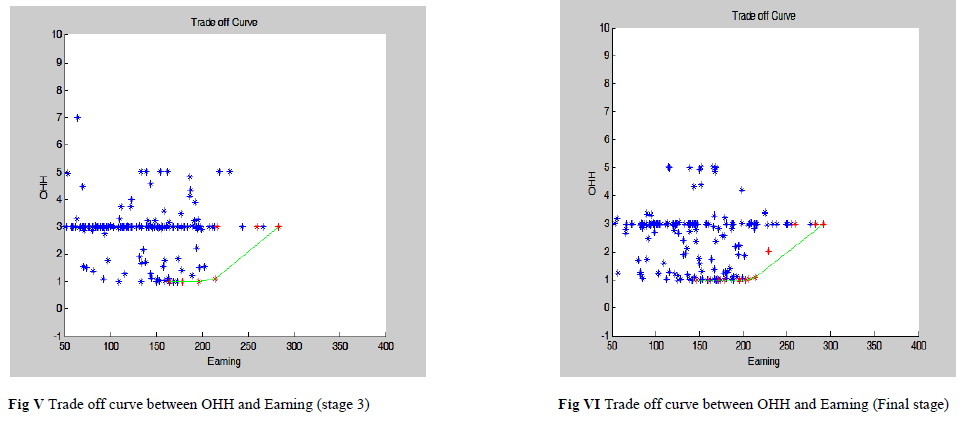 |
III. RESULTS AND CONCLUSION |
| Trade off curve (shown in fig III, IV, V, VI) shows optimum results between occupational health hazard and earning which can be summarized by giving some suggestions to workers for reducing the stresses in wrist and can increase the efficiency without reducing their earnings. In industry different types of tasks are done, so moulding worker have an option to change their job for few duration. This change will affect the wrist in fewer amounts as compared to moulding work and earning will be not affected. Worker can increase their working hours with increasing rest breaks. Rest breaks will provide more rest to workers and stresses will be reduced. Workers do their jobs in drastic environment without having medical facility. Stresses level can be reduced by providing good environment with good medical facility with routine checkup. |
References |
|